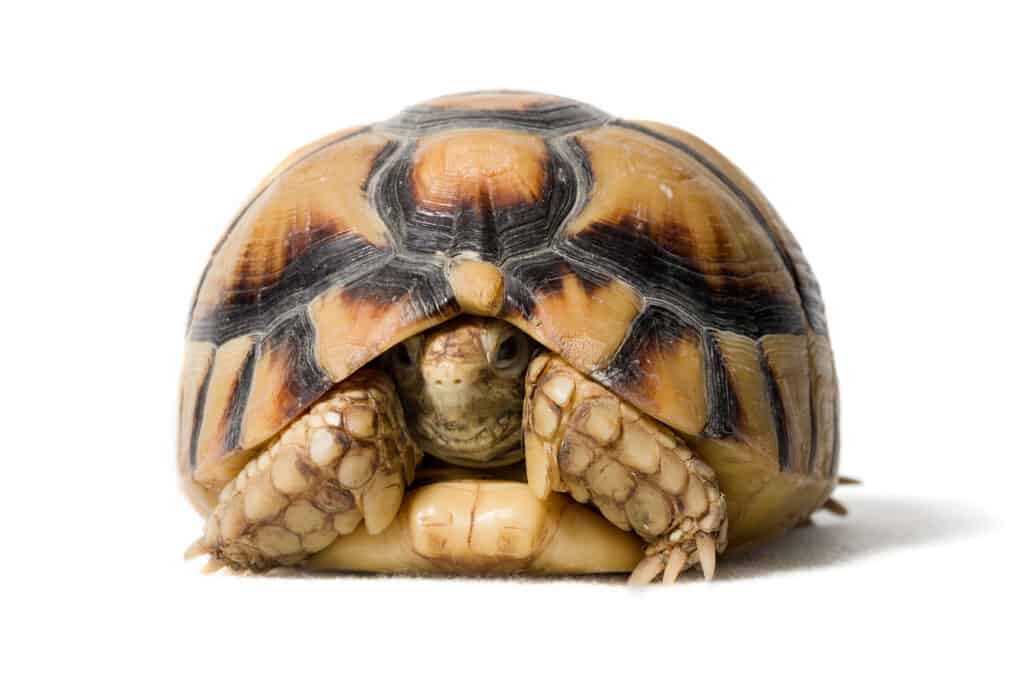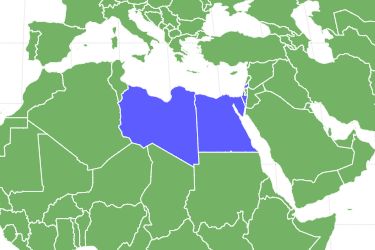Egyptian Tortoise
Testudo kleinmanni
The Egyptian tortoise is one of the smallest tortoise species in the world.
Advertisement
Egyptian Tortoise Scientific Classification
- Kingdom
- Animalia
- Phylum
- Chordata
- Class
- Reptilia
- Order
- Testudines
- Family
- Testudinidae
- Genus
- Testudo
- Scientific Name
- Testudo kleinmanni
Read our Complete Guide to Classification of Animals.
Egyptian Tortoise Conservation Status
Egyptian Tortoise Facts
- Name Of Young
- Hatchling
- Group Behavior
- Solitary
- Solitary/Group
- Fun Fact
- The Egyptian tortoise is one of the smallest tortoise species in the world.
- Biggest Threat
- Desert monitor lizards, birds, human activities
- Most Distinctive Feature
- Egyptian tortoises are very small and possess two triangular markings on their shell that get larger with age
- Other Name(s)
- Kleinmann's tortoise, Leith's tortoise, Negev tortoise
- Temperament
- Mild-tempered
- Incubation Period
- 70-111 days
- Habitat
- Arid and semi-arid lands on the edge of the Mediterranean Sea
- Predators
- Desert monitor lizards, birds
- Diet
- Herbivore
- Lifestyle
- Diurnal
- Favorite Food
- Grasses, leaves, and plant blooms
- Type
- Tortoise
- Common Name
- Egyptian Tortoise
- Origin
- Egypt, Libya and Israel
- Location
- Libya
- Average Clutch Size
- 5
Egyptian Tortoise Physical Characteristics
- Color
- Brown
- Grey
- Yellow
- Black
- Dark Brown
- Skin Type
- Hard Outer Shell
- Lifespan
- 70-100 years
- Weight
- 0.2-0.8 lbs
- Length
- 3-4 inches
- Age of Sexual Maturity
- 5 years
- Venomous
- No
- Aggression
- Low
View all of the Egyptian Tortoise images!
The Egyptian tortoise is one of the smallest tortoise species in the world.
Summary
The Egyptian tortoise is the second smallest tortoise in the world after the speckled tortoise. This tortoise is so small that it can comfortably fit into the palm of an average human. This species of tortoise used to be common throughout Egypt and Libya. However, they’re now on the verge of extinction due to the destruction and loss of their natural habitats to human activities.
5 Egyptian Tortoise Facts
- The Egyptian tortoise is the smallest in the northern hemisphere. You’ll need up to 400 Egyptian tortoises to make up the size of a single Galapagos tortoise.
- The Egyptian tortoise is an herbivore that typically feeds on grass.
- They come in gray, ivory, gold, dark brown, and yellow colorations, enabling them to blend in with their physical environment easily.
- An Egyptian tortoise reaches maturity after five years of age.
- The Egyptian tortoise does not hibernate. It is the only temperate reptile that is more active in winter than summer.
Egyptian Tortoise Scientific Name
The scientific name of the Egyptian Tortoise is Testudo kleinmanni. The specific name was given to the species in honor of the French stockbroker, Edouard Kleinmann, who collected the holotype of this species in 1875. The generic name “Testudo” means tortoise in Latin.
They are also called other names, such as Kleinmann’s tortoise, Leith’s tortoise, and Negev tortoise. The animal belongs to the class Reptilia and the family Testudinidae. They’re classified in the suborder Cryptodira (which means hidden neck in Greek) based on their ability to lower their neck and pull their head straight into their shells. Kleinmann’s tortoise does not have any subspecies.
Egyptian Tortoise Appearance and Behavior

The Egyptian tortoise does not hibernate. It is the only temperate reptile that is more active in winter than summer.
©Marlonneke Willemsen/Shutterstock.com
The Egyptian tortoise is the smallest tortoise species in the northern hemisphere. They’re the second smallest tortoise in the world (after South Africa’s speckled padloper). Like most tortoise species, they exhibit sexual dimorphism, with females bigger than their male counterparts. The average female’s carapace length is also about 4-5 inches against the 3-4 inches of the male. Conversely, males possess longer tails and have a slimmer body structure. The weight of the Egyptian tortoise is between 0.2 and 0.9 lbs (105-400 g).
The head and limbs of this tortoise are usually ivory-yellow or yellowish-brown. The plastron varies in color. The common colors are ivory, pale gold, dark brown, dull yellow, and gray. Apart from helping to keep the tortoise camouflaged, the pale colors also assist in thermal regulation. The paler the plastron is, the longer the tortoise can withstand heat. The scutes of the tortoise have dark edges that fade as they grow older. The carapace of the Testudo kleinmanni has a high dome with flared supracaudal scute.
Although Egyptian tortoises are primarily solitary animals, they relate well in groups, so cohabitation is possible. Generally, since they are non-aggressive, they can live with the same species or other calm animals. They are also precocial and cannot withstand regions with too much water. In captivity, they are best kept in a ratio of 1:3 in favor of the female or with other animals such as the agama lizard, girdled lizard, or the Egyptian spiny lizard.
Kleinmann’s tortoise does not hibernate. They mostly hide under bushes or other animal burrows and stay dormant in extreme hot seasons. They are only active early in the morning or late at night on hot days. During extreme cold seasons, they are active around midday.
Egyptian Tortoise Habitat
The Egyptian tortoise was once abundant in Libya, Egypt, and Israel. Presently, however, they are rare and almost extinct in these locations, especially in Egypt. They are still present in two locations in Libya—Tripolitania, and Cyrenaica. They live on the coastal strip that stretches from Libya to the delta of the river Nile.
Testudo kleinmanni inhabits desert and semi-desert regions with scattered rocks, compact gravel, dry woodlands, and coastal salt marshes. They do not migrate seasonally.
Predators and Threats
As expected of typical herbivores, the Egyptian tortoise feeds on grass, leaves, and plant blooms. They eat saltwort and sea lavender plants that naturally grow in their habitat. However, in the wild, they may feed on carrion and insects.
In captivity, their diet is usually high in calcium and fiber but low in protein. Greens rich in oxalic acid are harmful to Kleinmann’s tortoise. This is because oxalic acid reacts with calcium to form calcium oxalate. The compound reduces the amount of available calcium, results in kidney or bladder stones, and can eventually cause the animal’s death.
What Eats the Egyptian Tortoise?
Desert monitor lizards and birds, such as ravens, actively prey on Kleinmann’s tortoise and eggs. Since the tortoise is slow and small, predators can easily snatch and carry it away. However, the biggest threats to their population remain human activities, such as illegal pet trade and excessive consumption of these animals for food and medicinal purposes.
Other threats to these critically endangered species include the loss and deterioration of their habitat, pollution, and climate change. Urban encroachment, cultivation, and overgrazing have harmed their preferred natural habitats, reducing the vegetation that would have benefitted the tortoise as food and shelter.
Reproduction, Babies, and Lifespan
Scientists have very little information about the mating behavior of Egyptian tortoises. However, a few studies have been carried out on this subject. Typically, they reach sexual maturity at about five years old. There are speculations that they may either be polyandrous or polygynous. Their typical mating period is around March or April in the wild and between August to November in captivity.
The males make a loud noise while mating, similar to the call of a mourning dove. The male rams into the female at courtships, and there may be a chasing ritual.
Eggs are laid in groups of 1–5 in nests dug in the ground. They hatch after a gestation period of 4–5 months. The tortoise hatchlings are fragile, vulnerable, and tiny, weighing only 0.35 oz (10 g).
The life expectancy of Testudo kleinmanni is quite high. With proper care, they can live for as many as 100 years!
Population
The total population of Egyptian tortoises is estimated to be about 7470. Out of this figure, the mature ones are just about 5000. Kleinmann’s tortoise population has been labeled critically endangered by the IUCN because of the steady decline in its population.
Up Next
View all 117 animals that start with EEgyptian Tortoise FAQs (Frequently Asked Questions)
Do Egyptian tortoises bite?
Yes, they do. Despite their meek character, Egyptian tortoises, for different reasons, can bite one another, other pets, and even humans. However, the bites are not poisonous and may only cause bacterial infection.
Are Egyptian tortoises carnivores, herbivores, or omnivores?
The Egyptian tortoise has a herbivorous diet. In captivity, they eat grasses, fruits, and vegetables. However, their exact diet in the wild is not known. Scientists have speculated that their diet consists of grasses, flowers, and fruits. Since they live in arid environments, they may be adapted to eating cacti.
How big is the Egyptian tortoise?
The Egyptian tortoise is one of the smallest tortoise species in the world. Males typically measure between 3-4 inches(8-10 cm). Females are larger and may measure between 4-5 inches (10-12 cm) in length.
Thank you for reading! Have some feedback for us? Contact the AZ Animals editorial team.
Sources
- Animalia, Available here: https://animalia.bio/egyptian-tortoise
- Wikipedia, Available here: https://en.wikipedia.org/wiki/Kleinmann%27s_tortoise
- Lafeber Vet / Christal Pollock, Cindy Kanis, Available here: https://lafeber.com/vet/basic-information-sheet-egyptian-tortoise/

















